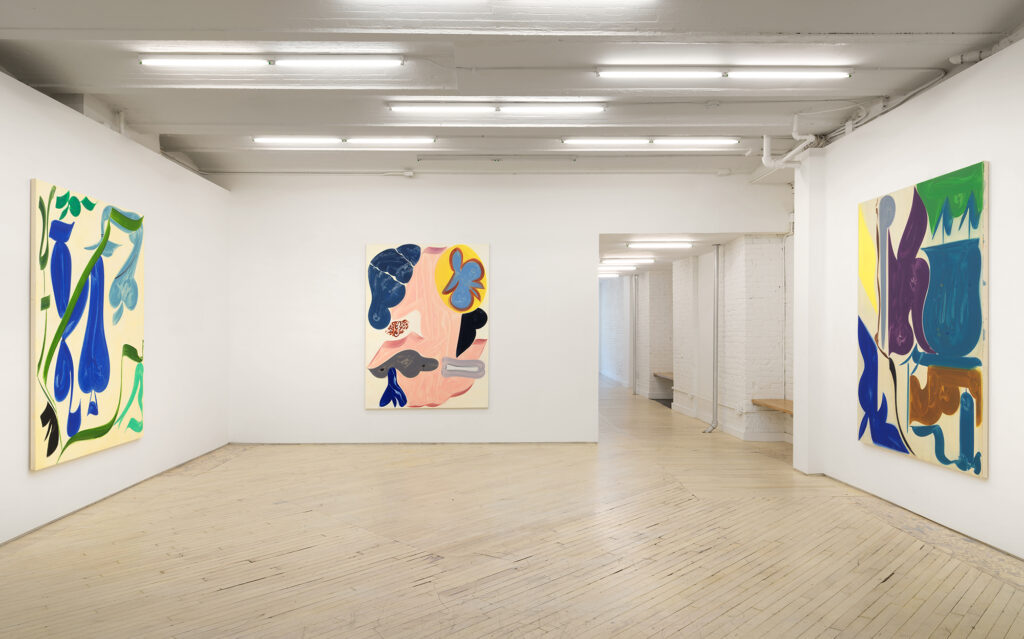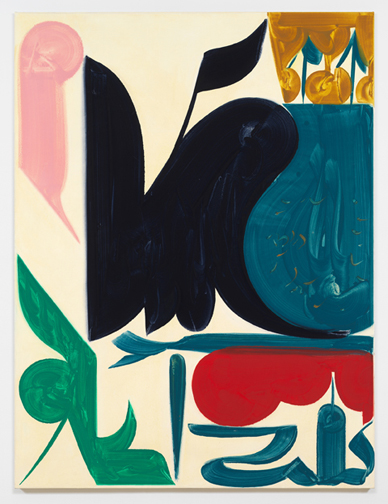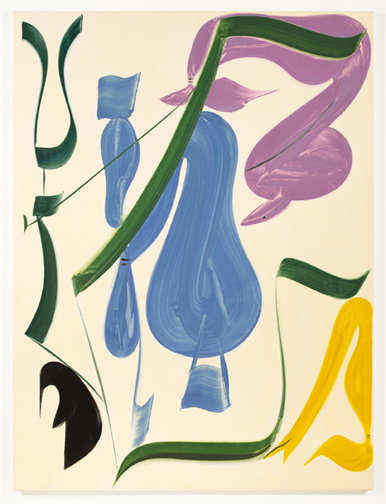Upon entry into the gallery on Norfolk Street, one is greeted by Interval —one of seven works in Patricia Treib’s second solo show at the gallery that appears as enigmatically current as it seems to be from another age.
At the center of the painting is a dark brown form, looking somewhat like a shape from a pre-17th century woodblock print, or a template for some archaic carved-wood furniture ornamentation. The quality of the paint is thin, yet saturated. The way that Treib’s brush moves through the loose liquid; it pools up the paint in some areas and becomes more opaque in others, leaving a trail behind that follows her movement as she turns corners or doubles back across the canvas.
Other shapes appear at the periphery—with shades of light blue, pink, magenta, and ochre. These forms interlock with each other like scattered pieces that are separate in quality but belong together in nature. The field they rest on has a slight yellowness to it, suggesting a distinctive age to the work, however, the gestures captured in the medium deliver another message of presentness and liveliness.

Courtesy of the artist and Bureau, New York
Treib’s bed-sized oils on canvas are satisfyingly visual and tactile. Her heightened sensitivity of medium, shape, and her awareness of the canvas’ edges approaches a “low-grade euphoria” that some today might call visual ASMR. However, rather than attempting to capture and stimulate a singular sense, Treib’s work rewards the viewer whose faculty of aesthesia—or their ability to sense in a wider context— is fully open and present to the experience of viewing and physically relating with it.

Oil on canvas
74 × 56 in.
Courtesy of the artist and Bureau, New York
Compositionally speaking, each painting feels to be a perfect balance of unbalanced elements. There appears to be no symmetry, for example; however, there is a lyrical and gestural balance throughout. The colors don’t appear to follow any order or pattern, but the palette of each canvas works together cohesively, as does the body of the works as a whole.

Oil on canvas
80 × 60 in.
Courtesy of the artist and Bureau, New York
In some works, such as Stems, Treib’s calligraphic and Chinese ink influence stands prominently. Here, her brush writes outlines that resemble letters—like a proto-language whose meaning is read across each form in the painting and connected like a string of grammar. Another consideration —due to their placement on the wall and the fluidic gesture— is an act similar to cave painting; where the artist’s presence seems to say “I was here”, while at the same time evoking scenes taken in from her personal experience of reality to share with others

Oil on canvas
74 × 56 in.
Courtesy of the artist and Bureau, New York
In addition to their visual and tactile aspects, Treib’s works deal with time and motion. On one level, there is the degree of time involved in their preparation —the sketching and rehearsal one imagines must go into their making. Because of the “one-shot” performance given on the canvas, there is almost an element of live theater involved. This is supported by the physical movement captured in each painting itself —literal recordings in oil of her arm’s motion (as suggested by the show’s title) across the surface. With the singularity and presence of her execution, experiential timeliness is elicited, causing us now to imagine ourselves there when they were made.
Further reflection on the presence of movement leads to an awareness of the body, where the effect of the works’ scale operates almost subconsciously. Due to their human scale and position on the wall in front of the viewer, it’s easy to read each painting as the presence of a body captured over a white field. While standing in front of them, this bodily presence naturally transitions into an awareness of one’s own, where one feels a sense almost of being lifted into each painting and interacting with the shapes and lines present therein. The anthropomorphic qualities of the shapes further support this experience, as does the realization that when making them, Treib lays them down on the floor so that her body occupies this field as well.

Courtesy of the artist and Bureau, New York
Individually, and as a body, Treib’s work heightens various sensory modes of life in a painting. They present a synthesis of sensory and organizational experience directed through a an awareness of vision, tactility, motion, and presence. They are an interface to take the world in through, and an aesthetic semiotics founded in gesture that returns back to it.
—Ian Pedigo


Leave a Reply